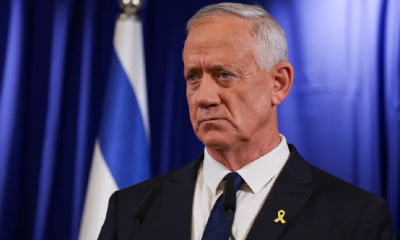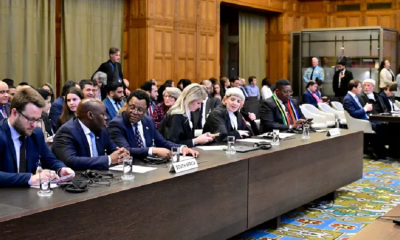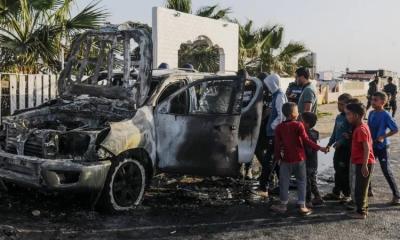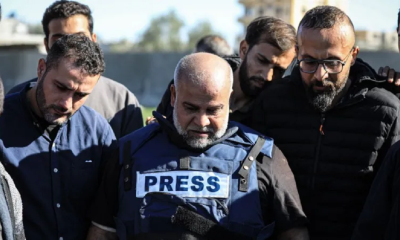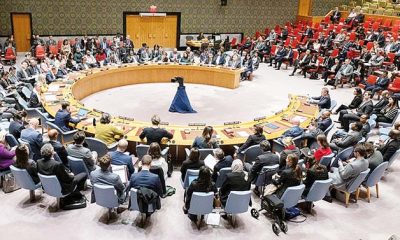Opinion
The mathematics of Israel
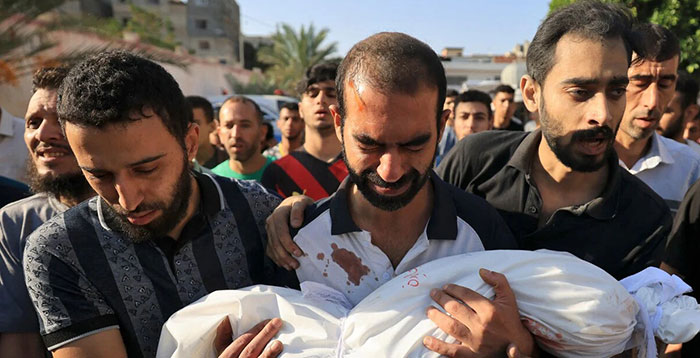
Zionism plus impunity:
By Bishop Duleep de Chickera
When the Secretary General of the UN, condemned the Hamas attack of 7/10 and cautioned the world to see it in context, he came under harsh criticism from Israel. But he was right. It is misleading to enter a conflict in the middle of the story.
The story of the Israeli-Palestinian conflict begins around the close of the 19th C-CE when organized groups of diaspora Jews descended on Palestine. They claimed the land was promised to them by God.
At that time Palestine was populated mostly by Arab Palestinians, (Muslims and Christians), and smaller communities of Jewish, Druze and Samaritan Palestinians, to whom the Jewish claim was audacious. Palestine was their land.
Today’s massacre of Palestinians updates the story. It tells of how a tenacious toe hold of a century ago has subjugated their land. Those who lived on it have lost their land, freedom, and more. Trapped and targeted, they face annihilation.
A mix of Zionism and impunity explain this travesty of justice.
Zionism
This ideology was provoked by the incessant anti-Semitic pogroms in Christian Europe, which persecuted Jews as “Christ Killers”. Under the direction of Theodore Herzl, the father of Zionism, Jewish suffering was shaped into a clamour for a homeland in Palestine.
Zionism is not Judaism. It has become an ethno-nationalist agenda, bent on occupying all of Palestine and ridding it of Palestinians.
Conversely, Judaism is the authentic religion of the Jews. Because it equates belief in God with loving care over ones’ neighbor, it has potential to co-exist with others. This difference explains todays’ opposition of numerous Jewish Israelis to the Zionist Israeli agenda.
The convergence of two factors has helped the Zionist agenda. The Balfour declaration that devised a homeland for Jews in Palestine, reflected European guilt. European Jews had to be compensated for European atrocities, but far away from Europe. Provision in the declaration for the protection of the rights and privileges of the then inhabitants of the land, has been proved to be a lie.
The other factor was the prevailing climate of western colonialism. The Zionist invasion of Palestine occurred when the plunder of other lands by some greedy nations, was the norm.
Impunity
Zionism alone could not have turned Israel into the bully it has become. The manipulation of western guilt, to equate any criticism of Zionism with anti-Semitism, earned Israel limitless impunity. Recent hearings by Congress into alleged Anti-Semitic protests in some Universities in the US, illustrates how this manipulation works.
Zionist impunity first manifest under the British mandate (1920-1948). Palestinians who fought Jewish invasion were branded as insurgents. Their leaders were exiled in the Seychelles and in a practice emulated by Zionist Israel, their dwellings, demolished. When the Palestinians revolted against Jewish land acquisition, Britain declared Martial law and trained Jewish Night Squads to hit back. These squads later evolved into the Israeli Defense Force (IDF).
When the conflict got out of hand, British attempts to partition the land and regulate Jewish immigration and land acquisition, came too late. Zionist Israel had smelt the power of impunity.
War and strategies
World War 11 and the horrendous holocaust, brought a flood of Jewish refugees into Palestine and further bolstered the Zionist agenda. With the declaration of the state of Israel in 1948 after the British mandate, war broke out between Israel and the surrounding Arab states, in support of the Palestinians. Israel-Egyptian tensions in 1967, led to a second devastating war.
Both wars stirred the trauma of the holocaust and doubled Zionist Israel’s resolve for a land of its own. Consequently, a more fervent fighting force, twice crushed Israel’s adversaries. A calculated cycle of forcible occupation followed; it expanded Israel’s boundaries to close in on its Zionist agenda.
As hundreds of Palestinian villages, mosques and churches were destroyed, millions of Palestinians displaced, exiled or detained and millions of acres of Palestinian land acquired; armed Israeli settler colonies were built where Palestinians lived and farmed, before.
Soon, ‘settler only’ roads and security walls bifurcated Palestinian villages and undermined Palestinian unity. Whenever friction developed between armed settlers and desperate stone throwing Palestinians, the IDF moved in to complete the next cycle of detention, displacement, more settler colonies and so on.
By the end of the 1948 war, Israel had occupied 77 % of Palestinian land including most of Jerusalem and the remaining 22% was annexed during the 1967 six-day war. At the beginning of 2023 the Israeli war machine had illegally established more than 150 settler colonies on Palestinian land. With all of Palestine under Israel, the subjugation of a people on their own soil was almost complete.
Two Israeli laws reinforced the Zionist agenda of total occupation. The Right to Return Law, welcomed Jews from anywhere in the world, and the draconian Absentee law, annulled Palestinian ownership after they were forced off their land.
With the inflow of large numbers of Jewish refugees and immigrants and the prevention of over two million Palestinian refugees from returning, the demography of Palestine changed drastically.
Israeli impunity, ensured by the US and its western allies had made these glaring violations of international humanitarian law and human rights, appear normal. As a victim of despicable crimes became a ruthless oppressor; its allies stood on the wrong side of history.
In the meantime, global endorsement for Palestinian self- determination, UN recognition of a Palestinian authority, UN observer status and the declaration of a Palestinian state in 1988, did little to change Israel’s attitude.
This rigidity provoked the rise of groups like the PLO, determined to liberate Palestine and its people from the yoke of Zionist occupation. This was typical of all peoples under wanton western colonialism. Had these Palestinians resisted German invasion during WW 11, they would have been honored as ‘The Resistance.’
With time, the secular PLO under Yasser Arafat, changed its stance to talk peace with the leftist Israeli PM, Rabin. Rabin’s daring to shift from violence to negotiations, cost him his life. Later on the emergence of Hamas, an armed Islamic group, intensified the conflict, as killings increased on both sides. Strained relations between the PLO and Hamas finally led to their separate but limited control over the West Bank and Gaza respectively.
Gaza
In 2005, the densely populated Gaza strip was disengaged as a non-profitable, volatile zone by Israel. After Israeli settlers in Gaza were compensated and resettled in the Palestinian West Bank, the Israeli withdrawal turned into a siege. The borders of the strip came under IDF control, and all movement in and out, including the supply of food, medicine and fuel by the UN Relief Work Agency, was brought under its scrutiny. Israel, a law to itself, had Gaza at its mercy.
Then came the incidents of 7/10.
Today the relentless bombardment of Gaza, the massacre of innocents, the targeting of hospitals, UN workers and Media personnel, as well as embargos on food, medicine and fuel, demonstrates the enormous power of unchecked impunity. In the name of ‘self-defense’ arbitrarily conferred by the US and some western allies, Israeli bombardment threatens to go on till Hamas is liquidated. The soaring numbers of civilian deaths and the recent white flag incident, in which Israeli hostages were killed on sight by the IDF, suggest that civilians will have to die for Hamas to be liquidated. After Gaza, it will be the West Bank, if not immediately, eventually.
A shared land
An ideal solution to this conflict, in an ideal world, is a shared land. If this is ever possible, the Palestinians will be free on their land and Israel free to live- ’in’-a land they believe to be a promise.
But there are two daunting prerequisites to a shared land.
1. It will not happen until the US protection of Israel stops, the discriminatory right of veto on the UN Security Council is repealed and the UN is empowered to do its work independently.
2. It cannot happen until investigations into war crimes by Israel and Hamas; and crimes against humanity and ethnic cleansing by Israel; are in place. Urgent negotiations cannot postpone investigations. Justice delayed in the name of peace, absolves the guilty.
If these requirements are bypassed, our world is likely to witness another genocide under our watch.
With peace and blessings to all!
Opinion
Gnana Moonesinghe- an appreciation

It was just over one month ago that Gnana Moonesinghe departed from this world after having lived a very fruitful life on this earth. It was indeed a privilege that Mallika and I came to know Gnana after we moved into Havelock City. During that short period, we became very close friends, along with another mutual friend of ours, Dr. Disampathy Subesinghe, who, too, was living in the same Tower after having come from the United Kingdom. Unfortunately, Dr. Subesinghe pre-deceased Gnana.
Gnana was a graduate of the University of Ceylon, Peradeniya having been at Peradeniya during the halcyon days of that University.
She tied the nuptial knot with Mangala Moonesinghe who was a very respected politician and who served as our High Commissioner in London and New Delhi. She was an exceptional hostess while being the wife of the High Commissioner. It was a very interesting coincidence that our second son, Anuke, had won a trip to New Delhi having won an All-Island essay competition about India while still a schoolboy. The team had met the High Commissioner and Gnana when they attended a reception hosted at the High Commission, where Gnana had been an exceptional hostess to the young boys.
Gnana was a member of many organisations and played an important role in all of them. In addition to these activities, she contributed to newspapers on varied subjects, especially relating to good governance and reconciliation. She was a keen player of scrabble and rummy with her friends and of course entertaining them to a meal if played at her home.
It was while in New Delhi that Gnana wrote and published a book titled “Thus have I heard…”in the year 2009 and she presented a copy to me). This book gives lucid descriptions of the Buddhist teachings of the Buddha and the places of interest in India with historical descriptions of what transpired in each place.
Gnana had brought up a very good daughter Avanthi and a son Sanath. She doted on her grandchildren and in turn they loved her. It was Avanthi and her husband, Murtaza who looked after Gnana during the last stages of her life.
We will miss Gana’s hospitality, soft spoken conversations, and the love that she used to emanate towards her friends.
HM NISSANKA WARAKAULLE
Opinion
Manifestos, promises and failures
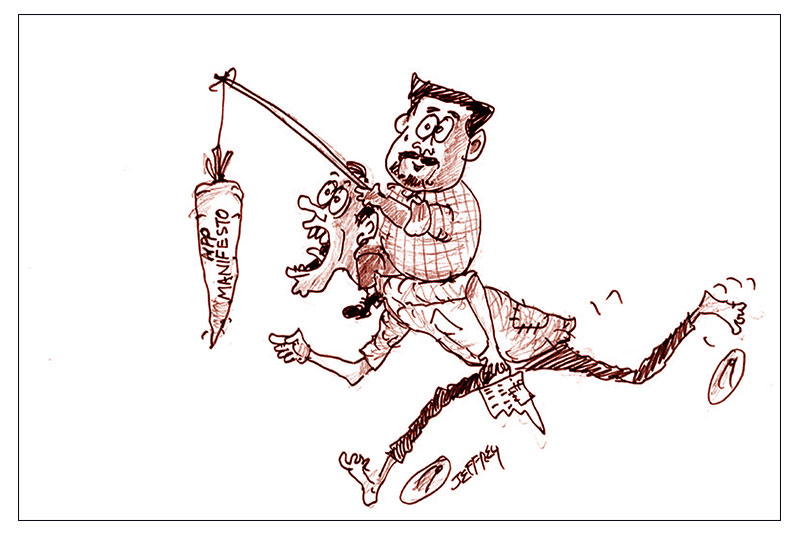
The current government’s spectacular electoral success, was in essence a clear rejection of the chaos, incompetence and corruption, that were hallmarks of the traditional parties that have exercised dominant electoral power since Independence in 1948.
The remarkably successful Aragalaya was an emphatic rejection of the ‘old’ parties and hopes of a refreshingly enlightened “System Change”. This was the unspoken reliance on the NPP, (a lightly disguised JVP).
The unsavoury history of the unimaginable and intolerable violence of the JVP, matched by an equally cruel retaliation by Government forces, thankfully faded out around the last decade of the 20th century, is still a feared eventuality, in the memories of those who experienced the nightmare. Maybe, most of the currently active youth, had not even been born at the time. But the fear lingers. It is not unusual that the current NPP leadership, is none too eager to remember that period of history, nor to market this ancestry.
The shift into oblivion of the LSSP, is perhaps a signal that the era of sloganeering and “catch phrases of Marxist verbiage” as electoral currency, is now past.
One hopes that a home-grown model, based on the rugged strengths of rural society, is much more marketable, and representative of the Swabasha nourished, youth leadership. The leader in this transformation, AKD stamps his class with remarkably effective oratorical skills. The ready recall of incidents and instances, to follow logical trends of thought, and the ease with which he changes style and substance, to suit his varied audiences, is simply brilliant. This, with not a note (or prompt) in support, nor an hour to craft his fresh delivery to a new audience. The massive crowds that attended the pre-election rallies, seem to have morphed significantly into votes. The 150-odd seats secured, would have surprised even the most committed supporters. However, can they “walk the talk” of electoral rhetoric?
It also seems that even the few of the Old Guard, possibly crippled by left wing ideology, have taken on a new stance, with emphasis on existing local reality.
The hopes of a majority, enthused by the change of attitudes, professionalism and integrity of the new dispensation, will endure and thrive. The early signs are positive, but this leopard may well change its spots.
The claim that the promised changes, especially of seizure of the proceeds of crime and lawful punishment of fraudsters, is demonstrably slow. There must however be much discomfort among these rogues, that the handcuffs to adorn their wrists, may not be too far away. The President assures the people that the seeming delay, was to allow irrefutable and water-tight evidence to be assembled for successful prosecution, and to eliminate the all too frequent instances where the accused are acquitted and released.
It is increasingly evident that the roots of criminality run deep and far, and even the institutions designed to aid in successful probes, can be compromised by massive enticements, which would be easily accommodated, within the sheer size of the sums involved.
The trails may be clear to the optimistic, but the craftiness of seasoned rogues ensures that although the truth will eventually prevail, it may be a very deep dig. If the lack of “legal provision” is a real impediment, the present parliamentary majority should facilitate speedy correction. However, in many instances, it seems apparent that it is not the lack of laws, but the tardiness in acting where sufficient laws already exist is the problem.
To return to the matter of lying or otherwise distorting reality, there seems to be a kind of permissible and generous threshold, beneath which unreal extravagance can be concealed. If conscience overrides mere legality, and zero tolerance of fraud prevails, there will be public aversion towards any departures from common decency and rectitude.
Credit will be its reward, for the “Clean Sri Lanka” initiative if it goes beyond mere elimination of environmental pollutants and encompasses restoration of moral and ethical standards as well.
But, are we not presently guilty of a shallow pretense of religiosity, when our Constitution urges (or permits), the creation of Ministries of Buddhism and those charged with the “protection” of Christian, Muslim or Hindu affairs? This is hypocrisy of a high order especially in a country, wedded to concepts of equality, compassion and fairness in a pluralistic community. It is infinitely easier to preserve unity in a mixed populace, than to repair a fractured one. As one of our political leaders asserted, in a different context, “We have scrambled the egg and invite any to try “unscrambling it”.
As the late D. M. Jayaratne, as PM, as well as Minister of Buddha Sasana, saw no qualms about declaring that “Only idiots would believe Election manifestos, when their intent was merely to deceive voters into voting for them”. One has to trust that this still prevails. We remain undaunted, in a country that prides itself in a religiosity cemented within a constitution which permits such divisive content.
Dr Upatissa Pethiyagoda
Opinion
Learning from global models to address flooding and water shortage in Sri Lanka

by Sudharman Siripala
Sri Lanka is grappling with the increasing threat of climate change, which has led to unpredictable weather patterns. The country faces a dangerous combination of flooding in some regions and water shortages in others, a situation exacerbated by shifting rainfall patterns. Rivers originating in the Central Hills, such as the Mahaweli, Kalu, and Kelani, flow through much of the country, but these water sources are not being distributed evenly. Districts like Monaragala and Hambantota, located in the dry zone, are experiencing severe water shortages. To address this challenge, experts suggest the development of an interconnected river system to harness excess water during floods and redirect it to drier areas, ensuring a year-round water supply for agriculture and daily use.
Global Case Studies in River Management
Several countries facing similar water-related challenges have implemented successful water management systems that Sri Lanka could adapt to its unique circumstances:
The Netherlands – Room for the River Programme
The Netherlands, a country prone to flooding, widened its rivers and relocated dikes to create floodplains. This approach allows rivers to overflow without damaging urban areas, while preserving water flow and natural habitats. Sri Lanka could apply this concept by designating specific riverbank areas for temporary flood storage.
China – South-North Water Transfer Project
China’s massive project channels excess water from the flood-prone Yangtze River to drier northern regions. This system of canals and reservoirs could inspire Sri Lanka to divert water from rivers in the Central Hills to drier areas in the south and east.
Bangladesh – River Interlinking Projects
Bangladesh has implemented river interlinking projects to redistribute water from flood-prone rivers, such as the Brahmaputra, to drier regions. Sri Lanka could link its major rivers like the Mahaweli and Kelani to smaller rivers in water-scarce districts to balance water distribution.
India – National River Linking Project
India’s National River Linking Project connects major rivers to manage both floods and droughts. Sri Lanka could use similar strategies, connecting rivers around the 500-foot contour line in the Central Hills to help distribute water more effectively.
United States – Mississippi River and Tributaries Project
The Mississippi River system combines levees, floodways, and diversion channels to manage flooding. Sri Lanka could adopt similar flood-control measures in vulnerable river basins such as the Kelani and Kalu.
Japan – Underground Reservoirs and Flood Channels
Japan’s G-Cans Project in Tokyo channels excess water into underground reservoirs to prevent urban flooding. A similar underground system could be implemented in Colombo and other flood-prone cities in Sri Lanka.
Singapore – Marina Barrage
Singapore’s Marina Barrage serves as both a flood control measure and a water supply resource. Sri Lanka could develop similar systems to control flooding in urban areas and ensure water availability during dry spells.
Thailand – Chao Phraya River Basin Management
Thailand uses diversion channels in the Chao Phraya River Basin to prevent flooding in Bangkok and direct water to agricultural areas. Sri Lanka could replicate this by creating diversion channels to supply water to its agricultural zones.
Actionable Solutions for Sri Lanka
Develop an Interconnected River System
Establish water diversion channels along the 300-500 meter contour lines of the Central Hills to capture excess rainfall during floods and redirect it to drier areas.
Build Reservoirs and Storage Tanks
Construct reservoirs to store diverted water, ensuring a steady supply for agriculture and domestic use. Sri Lanka has around 14,000 ancient tanks out of 30,000 that could be revitalized for this purpose.
Improve Urban Flood Defenses
Drawing inspiration from Japan and Singapore, build underground reservoirs and flood channels in cities like Colombo to mitigate urban flooding.
Strengthen Watershed Management
Restore natural floodplains and create wetlands to absorb excess rainwater, as seen in the Netherlands, helping to reduce flood risks.
Encourage Public-Private Partnerships
Foster collaboration between the public and private sectors to fund large-scale water management infrastructure, leveraging models from China and the United States.
Leverage Technology
Utilise modern forecasting and real-time water management systems, similar to those in Bangladesh and Thailand, to monitor water levels and manage river flows dynamically.
International Collaboration
Form partnerships with countries that have successfully implemented flood control and water management systems to share expertise and technology.
Sri Lanka’s dual challenges of flooding and water scarcity, compounded by climate change, require immediate action. By developing an interconnected river system and learning from successful global water management models, Sri Lanka can mitigate the effects of floods while ensuring a sustainable water supply for agriculture and daily life. It is crucial for the country to act now, as these solutions have the potential to transform Sri Lanka’s water management system for the better.
Sudharman Siripala Managing Director of Geoinformatics Group and a Registered Licensed Surveyor, specializes in geo-spatial applications. He also serves as a freelance value chain consultant for Vivonta Green Tech Consultants (www.vivonta.lk)
-
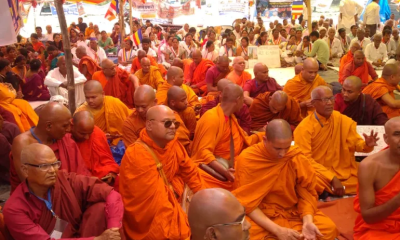
 Foreign News7 days ago
Foreign News7 days agoBuddhism’s holiest site erupts in protests over Hindu ‘control’ of shrine
-

 Features5 days ago
Features5 days agoCelebrating 25 Years of Excellence: The Silver Jubilee of SLIIT – PART I
-

 Sports1 day ago
Sports1 day agoSri Lanka’s eternal search for the elusive all-rounder
-

 Business3 days ago
Business3 days agoAIA Higher Education Scholarships Programme celebrating 30-year journey
-

 Business5 days ago
Business5 days agoCEB calls for proposals to develop two 50MW wind farm facilities in Mullikulam
-

 News2 days ago
News2 days agoGnanasara Thera urged to reveal masterminds behind Easter Sunday terror attacks
-

 Features5 days ago
Features5 days agoNotes from AKD’s Textbook
-

 News1 day ago
News1 day agoComBank crowned Global Finance Best SME Bank in Sri Lanka for 3rd successive year


